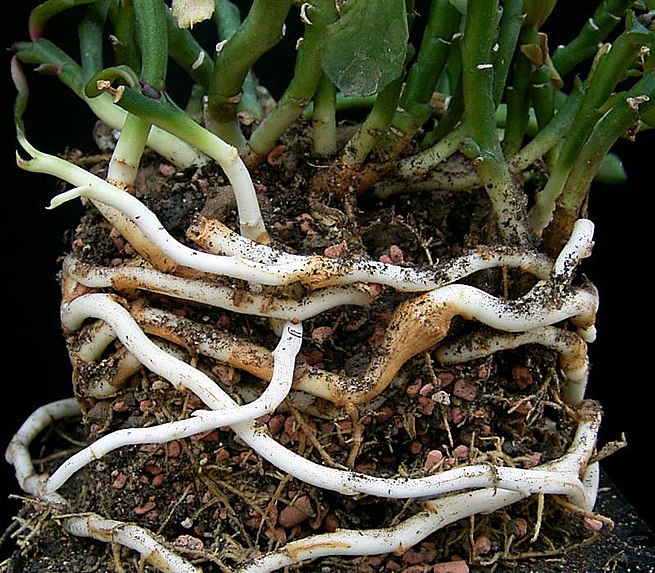
-
Rhizoid
Rhizoids are protuberances that extend from the lower epidermal cells of bryophytes and algae. They are similar in structure and function to the root hairs of vascular land plants. Similar structures are formed by some fungi. Rhizoids may be unicellular or multicellular. Roots are multicellular organs composed of multiple tissues that collectively carry out a common function.Plants originated in aquatic environments and gradually migrated to land during their long course of evolution. In water or near it, plants could absorb water from their surroundings, with no need for any special absorbing organ or tissue. Additionally, in the primitive states of plant development, tissue differentiation and division of labor was minimal, thus specialized water absorbing tissue was not required. Once plants colonized land however, they required specialized tissues to absorb water efficiently, and also to anchor themselves to the land.
Rhizoids absorb water by capillary action, in which water moves up between threads of rhizoids and not through each of them as it does in roots.In fungi, rhizoids are small branching hyphae that grow downwards from the stolons that anchor the fungus to the substrate, where they release digestive enzymes and absorb digested organic material. That is why fungí are called heterotrophs by absorption.
In land plants, rhizoids are trichomes that anchor the plant to the ground. In the liverworts, they are absent or unicellular, but multicelled in mosses. In vascular plants they are often called root hairs, and may be unicellular or multicellular.
In certain algae, there is an extensive rhizoidal system that allows the alga to anchor itself to a sandy substrate from which it can absorb nutrients. Microscopic free-floating species, however, do not have rhizoids at all.
-
Rhizome
In botany and dendrology, a rhizome (, from Ancient Greek: rhízōma “mass of roots”, from rhizóō “cause to strike root”) is a modified subterranean plant stem that sends out roots and shoots from its nodes. Rhizomes are also called creeping rootstalks or just rootstalks. Rhizomes develop from axillary buds and grow horizontally. The rhizome also retains the ability to allow new shoots to grow upwards.A rhizome is the main stem of the plant. A stolon is similar to a rhizome, but a stolon sprouts from an existing stem, has long internodes, and generates new shoots at the end, such as in the strawberry plant. In general, rhizomes have short internodes, send out roots from the bottom of the nodes, and generate new upward-growing shoots from the top of the nodes.
A stem tuber is a thickened part of a rhizome or stolon that has been enlarged for use as a storage organ. In general, a tuber is high in starch, e.g. the potato, which is a modified stolon. The term “tuber” is often used imprecisely and is sometimes applied to plants with rhizomes.
If a rhizome is separated each piece may be able to give rise to a new plant. The plant uses the rhizome to store starches, proteins, and other nutrients. These nutrients become useful for the plant when new shoots must be formed or when the plant dies back for the winter. This is a process known as vegetative reproduction and is used by farmers and gardeners to propagate certain plants. This also allows for lateral spread of grasses like bamboo and bunch grasses. Examples of plants that are propagated this way include hops, asparagus, ginger, irises, lily of the valley, cannas, and sympodial orchids.
Some rhizomes that are used directly in cooking include ginger, turmeric, galangal, fingerroot, and lotus.
Stored rhizomes are subject to bacterial and fungal infections, making them unsuitable for replanting and greatly diminishing stocks. However, rhizomes can also be produced artificially from tissue cultures. The ability to easily grow rhizomes from tissue cultures leads to better stocks for replanting and greater yields. The plant hormones ethylene and jasmonic acid have been found to help induce and regulate the growth of rhizomes, specifically in rhubarb. Ethylene that was applied externally was found to affect internal ethylene levels, allowing easy manipulations of ethylene concentrations. Knowledge of how to use these hormones to induce rhizome growth could help farmers and biologists producing plants grown from rhizomes more easily cultivate and grow better plants.
Some plants have rhizomes that grow above ground or that lie at the soil surface, including some Iris species, and ferns, whose spreading stems are rhizomes. Plants with underground rhizomes include gingers, bamboo, the Venus flytrap, Chinese lantern, western poison-oak, hops, and Alstroemeria, and the weeds Johnson grass, Bermuda grass, and purple nut sedge. Rhizomes generally form a single layer, but in giant horsetails, can be multi-tiered.Many rhizomes have culinary value, and some, such as zhe’ergen, are commonly consumed raw.
-
Rhizoid (noun)
A fungi and some plants that acts as support and/or aids the absorption of nutrients.
-
Rhizoid (adjective)
Resembling the root of a plant.
-
Rhizome (noun)
A horizontal, underground stem of some plants that sends out roots and shoots from its nodes.
-
Rhizome (noun)
A so-called “image of thought” that multiplicities. See Rhizome (philosophy).
